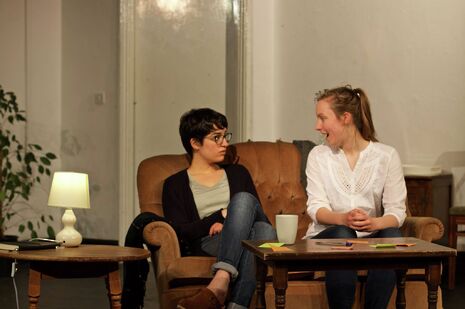Review: Ashes to Ashes
Miranda Imperial thoroughly enjoys this poignant retelling of one of Pinter’s most challenging works

Ashes to Ashes is immersive to the point that it leaves you there, helpless, gasping for the breath of fresh air that only arrives with its end. And it is at that moment that you cannot help but ponder about what you just witnessed.
A confusing work, Ashes to Ashes is a one-act play where two characters engage in deep conversation about themes that seem out of place. The audience cannot ever understand if the characters truly speak of impersonal visions, or rather, of emotions at the core of their being. Reality and delusion are inextricably linked, unable to discern fact from fiction in the recollection process.
The characters of Rebecca and Devlin engage in numerous interactions. The decision to cast two female leads gives the play a refreshing perspective. At the same time, the cast’s precision in maintaining the power dynamics of the relationship generates an unsettling atmosphere. As Devlin stands, imposingly, at the back of the stage, her looming shadow projected onto the barren walls of the Corpus Playroom, Rebecca sits on a sofa, rarely looking at Devlin, perhaps out of fear, or maybe disdain. It is the danger lurking in every threatening glare and gesture that materialises, the danger in the exchanges, dominated by a relationship more suited to a patient and her therapist than any other kind, that made this production memorable.
The cast and crew have attained a near perfect interpretation of Pinter. Despite being one of his later works, the influence of his ‘memory plays’ on this production has not been neglected, with recollection and its fleeting, elusive margins at the heart of the outstanding acting. Even managing to portray the political by addressing the clear references to the Holocaust with radio recordings concerning the Jewish community in the United Kingdom, the director, Joe Richards, has put together a captivating performance.
Beatriz Santos offers an intriguing portrayal of Rebecca’s retrospection. The slightest glances and motions depict her to be deep in thought, her ambivalent looks into nothingness. These reveal the rawness of her emotions, yet conceal their origins, clouding her in a veil of mystery. For every stare, every slight tilt of the head, even the brushing of a plant leaf with the touch of a hand, can be appreciated in the intimacy of the Corpus Playroom.
This is key for Pinter, who sometimes, with actions speaking louder than words in silences, transposes the theatrical into the cinematic, a transition that is not overlooked by the actresses. Their movements are calm and slow, such as those acted out by Rebecca by placing her body back into the sofa, with the powerful image of her lover’s threat to strangle her as backdrop. Unforgettable and engraved in the audience’s minds, these actions portray the sensuous peril lurking in every line of Pinter.
Kathryn Cussons, as Devlin, does not disappoint. It is her intense, visceral stares at the back of Rebecca’s head that evoke her apparent uneasiness. Her portrayal of one of Pinter’s arguably most difficult characters evinces a commanding force that can exude the toxic emotions of jealousy and disdain with the utterance of a just few words. The production’s depiction of Devlin in this role of ‘bad therapist’, with complete disregard for any of the memories important to Rebecca, brushing them aside with her demeanour, reinforces the mystery built around their uncommon relationship.
The predominantly short utterances of the script could have been performed in a typical, realistic emulation of normal conversation. However, the cast and crew have prepared well to deliver that dreamy, introspective aura that only a play interrupted by Pinteresque pauses can offer. The changes of disposition and restrained emotions in these moments evade the audience as words stop flowing. In Pinter, less is more: everything is left unsaid.
As a very characteristic playwright, Pinter is a complex author to interpret. His signature often cannot help but cast its shadow over his plays, leaving little room for directorial interpretation without completely deviating from the feelings originally conjured by the script. It must have been difficult for the director to personalise Ashes to Ashes. However, it is the combination of technical decisions, both lighting and sound design, along with specific ways in which certain scenes are conducted, that manage to incorporate personality into the play.
 Comment / Anti-trans societies won’t make women safer14 November 2025
Comment / Anti-trans societies won’t make women safer14 November 2025 News / Controversial women’s society receives over £13,000 in donations14 November 2025
News / Controversial women’s society receives over £13,000 in donations14 November 2025 News / John’s rakes in £110k in movie moolah14 November 2025
News / John’s rakes in £110k in movie moolah14 November 2025 Comment / Be mindful of non-students in your societies12 November 2025
Comment / Be mindful of non-students in your societies12 November 2025 News / Home Office denied PhD student visa to attend graduation14 November 2025
News / Home Office denied PhD student visa to attend graduation14 November 2025









